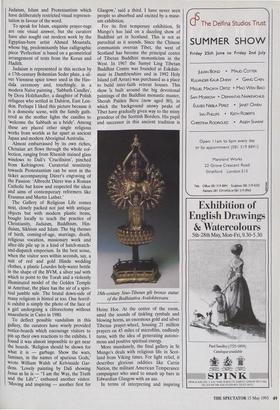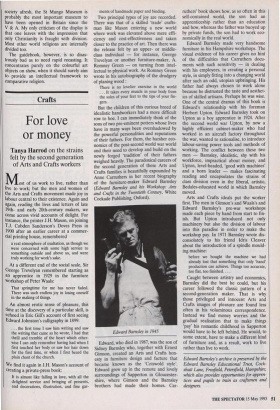Museums
Many mansions
Alexandra Artley visits a new museum of religious life and art in Glasgow After the Bengali mystic Sri Rama- krishna claimed to have had visions of both Jesus and Mohammed, Hinduism became the only world religion to pull into its orthodoxy the idea that all religions are equally good and true. Given this peculiar tolerance, a big modern statue of the Hindu god Ganesha — pink-bellied and with a lovable elephant's head — is appro- priately placed as the first show-stopper a visitor sees in the new St Mungo Museum of Religious Art and Life in Glasgow.
Ganesha is the Hindu patron of business activity and influence, success and plenty. To one side of the statue, a curatorial plaque merely remarks, appropriately, that Ganesha is 'particularly invoked at the beginning of new and potentially risky undertakings'.
The St Mungo Museum is housed in a handsome new building of honey-coloured stone designed in modern Scottish Baronial by the nationalist architect Ian Begg. Standing in the new precinct of St Mungo's Cathedral, it started out as a visitor's cen- tre in order to clear tourist clutter from the cathedral. When money ran short, Glasgow Council, with its usual quick-wittedness, stepped in with the idea of converting the project into a museum of religion. This has been done with elegantly fitted-out interi- ors by the architects Page & Park. Glasgow is a city which continues to take religion rather seriously. It says a great deal for the tolerance and dignity of the modern Church of Scotland that what amounts to the first museum of comparative religion in the world is now sited within yards of the city's most ancient Christian shrine.
To avoid cultural offence in terms of food and drink, a pleasing, white-vaulted café is vegetarian/vegan and licensed for alcohol for private parties only. Its doors open out on to the first permanent Zen Buddhist garden in Britain, and beyond that the ragged, swooping shapes of the Glasgow Necropolis rise up with High Vic- torian craziness through the inevitable haze of western Scottish rain.
One curatorial problem in a museum of comparative religion emerges in the very first gallery, devoted to religious art. Whereas Hinduism, Catholicism and Bud- dhism abound in big art objects, it is diffi- cult to represent adequately faiths such as Judaism, Islam and Protestantism which have deliberately restricted visual represen- tation in favour of the word.
To speak for Islam, exquisite prayer-rugs are one visual answer, but the curators have also sought out modern work by the Egyptian-born artist Ahmed Moustafa, whose big, predominantly blue calligraphic piece 'Perfection' is based on a geometrical arrangement of texts from the Koran and Hadith.
Judaism is represented in this section by a 17th-century Bohemian Seder plate, a sil- ver Viennese spice tower used in the Hav- dala ceremony and, touchingly, in a modern Naive painting , 'Sabbath Candles', by Dora Holzhandler, a daughter of Polish refugees who settled in Dalston, East Lon- don. Perhaps I liked this picture because it is a domestic scene, with the family gath- ered as the mother lights the candles to `welcome the Sabbath as a bride'. Among these are placed other single religious works from worlds as far apart as ancient Japan and modern Aboriginal Australia.
Almost embarrassed by its own riches, Christian art flows through the whole col- lection, ranging from Rhenish stained glass windows to Dali's 'Crucifixion', pinched from Kelvingrove. Curatorial sensitivity towards Protestantism can be seen in the ticket accompanying Diirer's engraving of the Passion: 'Albrecht Darer was a Roman Catholic but knew and respected the ideas and aims of contemporary reformers like Erasmus and Martin Luther.'
The Gallery of Religious Life comes next, closely packed not just with antique objects but with modern plastic items, bought locally to teach the practice of Christianity, Judaism, Buddhism, Hin- duism, Sikhism and Islam. The big themes of birth, coming-of-age, marriage, death, religious vocation, missionary work and after-life pile up in a kind of hatch-match- and-dispatch emporium. In the best sense, when the visitor sees within seconds, say, a suit of red and gold Hindu wedding clothes, a plastic Lourdes holy-water bottle in the shape of the BVM, a silver yad with which to point to the Torah and a violently illuminated model of the Golden Temple at Amritsar, the place has the air of a spiri- tual jumble sale. The brutal down-side of many religions is hinted at too. One horrif- ic exhibit is simply the photo of the face of a girl undergoing a clitorectomy without anaesthetic in Cairo in 1980.
To deflect possible vandalism in this gallery, the curators have wisely provided notice-boards which encourage visitors to pin up their own reactions to the exhibits. I found it was almost impossible to get near the boards. 'Religion should be shown for what it is — garbage. Show the wars, famines, in the names of spurious Gods,' wrote William Walsh of Kelvinside Gar- dens. 'Lovely painting by Dali showing Jesus as he is — "I am the Way, the Truth and the Life",' enthused another visitor. `Moving and inspiring — another first for
Glasgow,' said a third. I have never seen people so absorbed and excited by a muse- um exhibition.
For its first temporary exhibition, St Mungo's has laid on a dazzling show of Buddhist art in Scotland. This is not as parochial as it sounds. Since the Chinese communists overran Tibet, the west of Scotland has become the principal centre of Tibetan Buddhist monasticism in the West. In 1967 the Samye Ling Tibetan Buddhist Centre was founded at Eskdale- muir in Dumfriesshire and in 1992 Holy Island (off Arran) was purchased as a place to build inter-faith retreat houses. This show is built around the big devotional paintings of the Buddhist monastic master, Sherab Palden Beru (now aged 80), in which the background snowy peaks of Tibet have gradually given way to the misty grandeur of the Scottish Borders. His pupil and successor in this ancient tradition is 18th-century Sino-Tibetan gilt bronze statue of the Bodhisattva Avalokitesvara
Heinz Hoe. At the centre of the room, amid the sounds of tinkling cymbals and blowing horns, an enormous gold and silver Tibetan prayer-wheel, housing 21 million prayers on 45 miles of microfilm, endlessly turns, with the idea of generating autono- mous and positive spiritual energy.
More mundanely, the final gallery in St Mungo's deals with religious life in Scot- land from Viking times. For light relief, it describes glorious oddities like Carrie Nation, the militant American Temperance campaigner who used to smash up bars in Edwardian Glasgow with an axe.
In terms of interpreting and inspiring society afresh, the St Mungo Museum is probably the most important museum to have been opened in Britain since the V & A. My only criticism of the display is that one leaves with the impression that only Christianity is fraught with division. Most other world religions are internally divided too.
The guidebook, however, is so disas- trously bad as to need rapid recasting. It concentrates purely on the colourful art objects on show, when it should surely aim to provide an intellectual framework to comparative religion.




































































 Previous page
Previous page